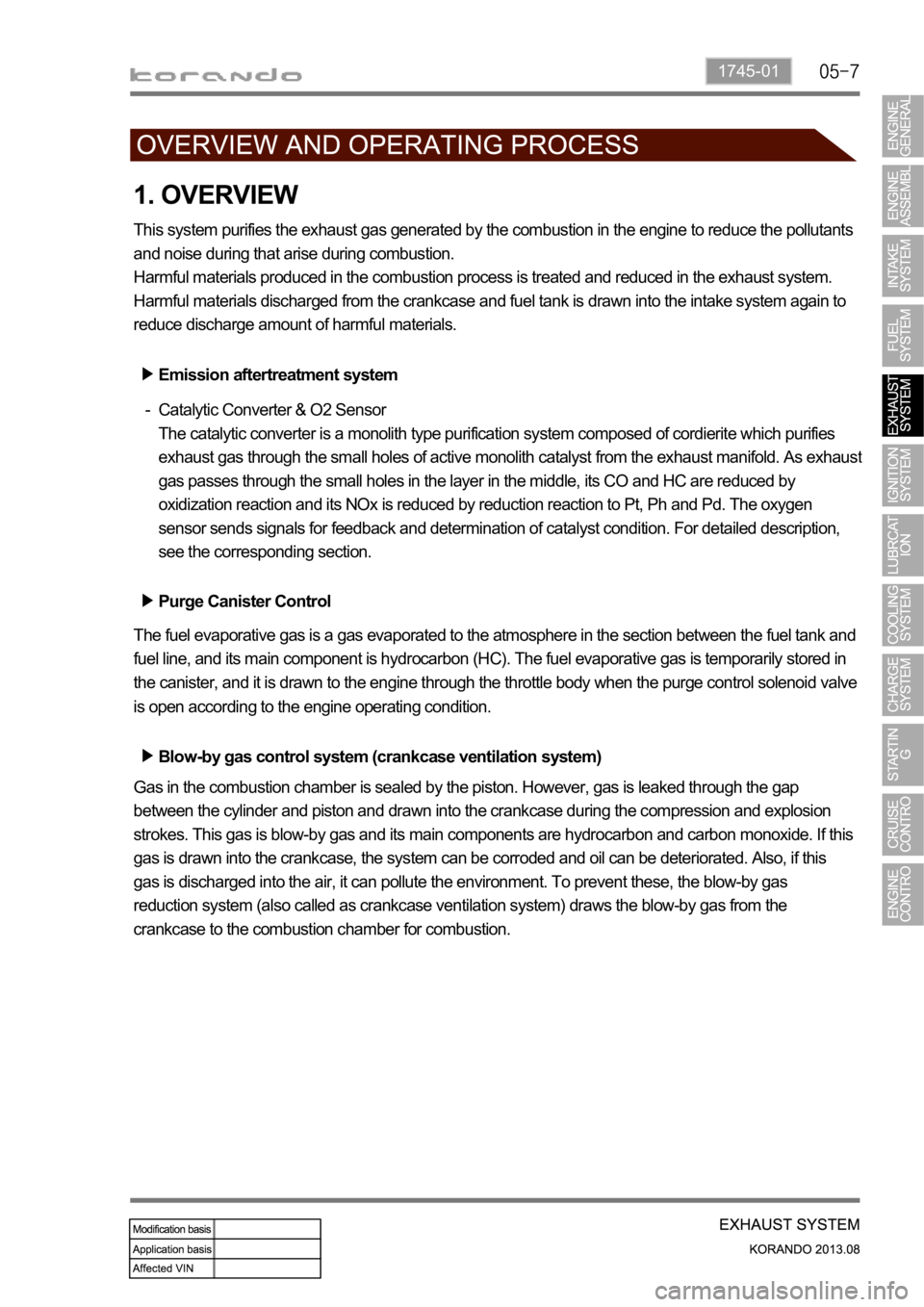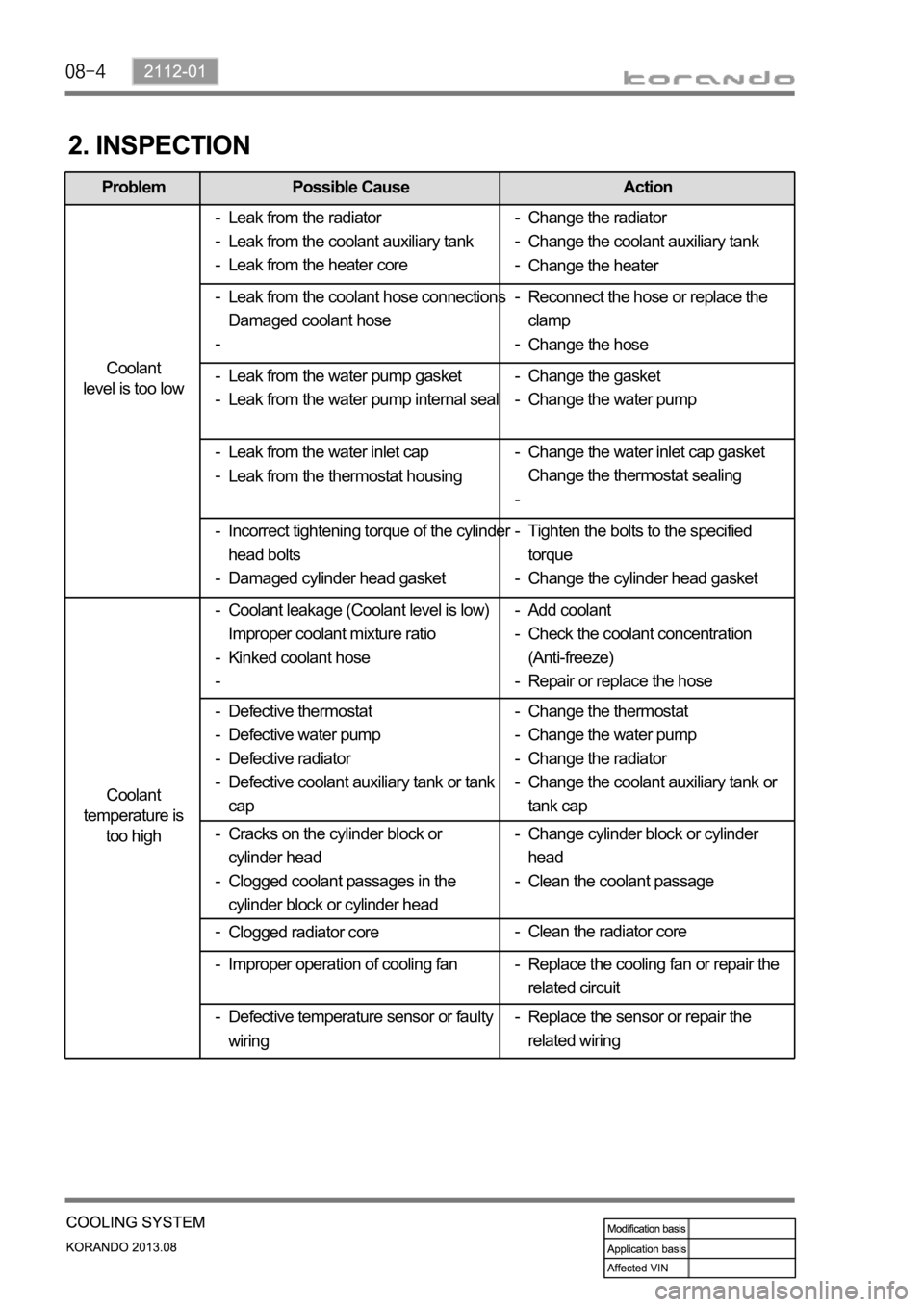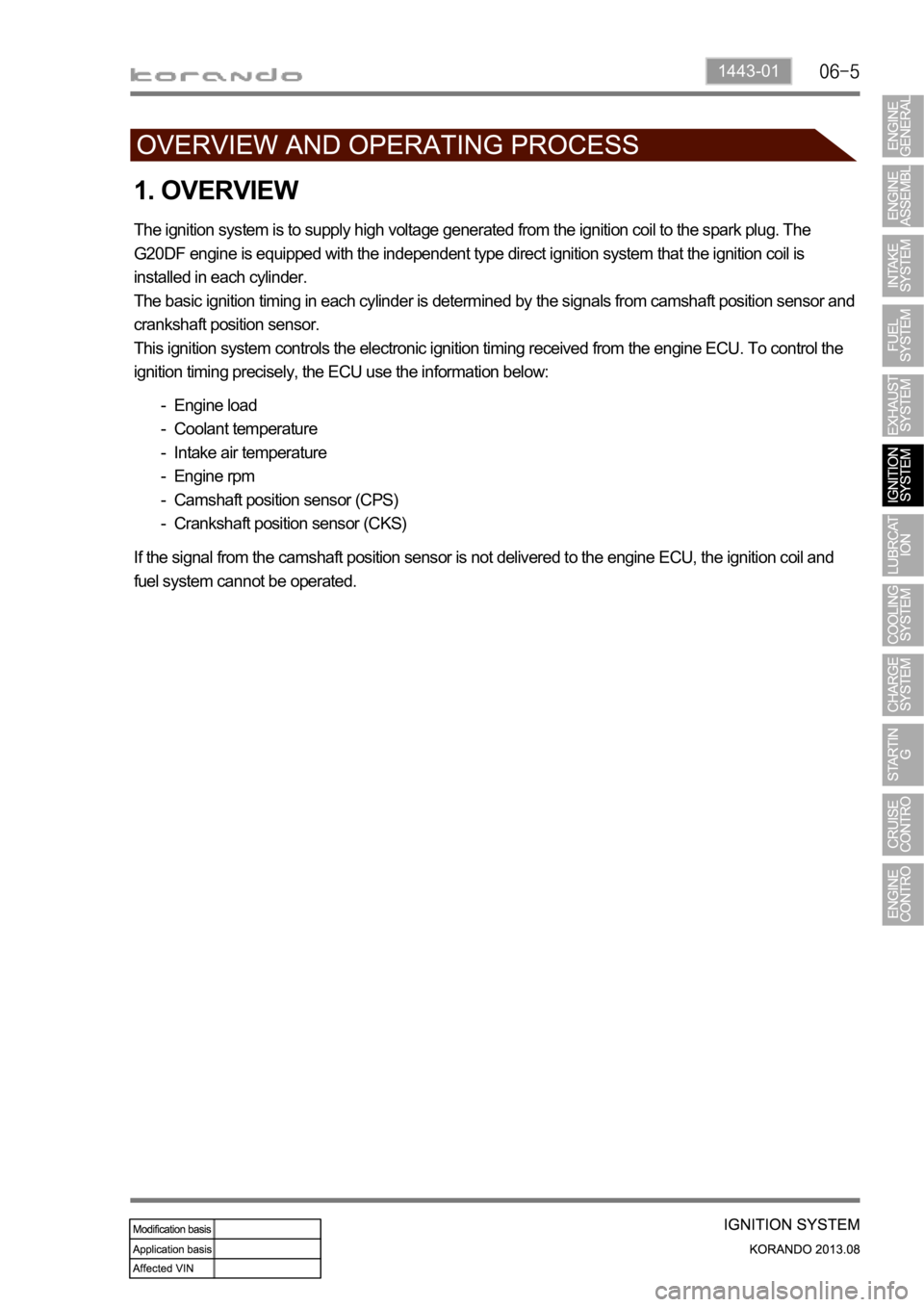SSANGYONG KORANDO 2013 Repair Manual
KORANDO 2013
SSANGYONG
SSANGYONG
https://www.carmanualsonline.info/img/67/57503/w960_57503-0.png
SSANGYONG KORANDO 2013 Repair Manual
Page 473 of 1336
2. LAYOUT
Intake Manifold Assy
Bolt
T-MAP sensor
Bolt
Intake Manifold Brkt 1.
2.
3.
4.
5.Bolt
Electric Throttle Body
Bolt
Acoustic Cover 6.
7.
8.
9.
Page 475 of 1336
Intake manifold assembly
T-MAP sensorVIS valve
1. OVERVIEW
To improve the engine performance, the VIS system has been introduced in the intake manifold. It
And, to reduce the internal pulsation in the intake manifold, the Runner # 1 and #2 are located in
2. COMPONENTS
VIS solenoid valve
Page 488 of 1336
2221-01
4. INPUT/OUTPUT DEVICES
The engine ECU calculates the accelerator pedal based on the input signals from various sensors, and
controls the overall operation of the vehicle.
The ECU receives the signals from various sensor through data line, and performs effective airfuel ratio
control based on these signals.
Page 493 of 1336

1745-01
1. OVERVIEW
This system purifies the exhaust gas generated by the combustion in the engine to reduce the pollutants
and noise during that arise during combustion.
Harmful materials produced in the combustion process is treated and reduced in the exhaust system.
Harmful materials discharged from the crankcase and fuel tank is drawn into the intake system again to
reduce discharge amount of harmful materials.
Emission aftertreatment system
Catalytic Converter & O2 Sensor
The catalytic converter is a monolith type purification system composed of cordierite which purifies
exhaust gas through the small holes of active monolith catalyst from the exhaust manifold. As exhaus
t
gas passes through the small holes in the layer in the middle, its CO and HC are reduced by
oxidization reaction and its NOx is reduced by reduction reaction to Pt, Ph and Pd. The oxygen
sensor sends signals for feedback and determination of catalyst condition. For detailed description,
see the corresponding section. -
The fuel evaporative gas is a gas evaporated to the atmosphere in the section between the fuel tank and
fuel line, and its main component is hydrocarbon (HC). The fuel evaporative gas is temporarily stored in
the canister, and it is drawn to the engine through the throttle body when the purge control solenoid valve
is open according to the engine operating condition.
Gas in the combustion chamber is sealed by the piston. However, gas is leaked through the gap
between the cylinder and piston and drawn into the crankcase during the compression and explosion
strokes. This gas is blow-by gas and its main components are hydrocarbon and carbon monoxide. If this
gas is drawn into the crankcase, the system can be corroded and oil can be deteriorated. Also, if this
gas is discharged into the air, it can pollute the environment. To prevent these, the blow-by gas
reduction system (also called as crankcase ventilation system) draws the blow-by gas from the
crankcase to the combustion chamber for combustion.
Purge Canister Control
Blow-by gas control system (crankcase ventilation system)
Page 495 of 1336
2414-00
Rear oxygen sensor
Exhaust No.2Exhaust No.1Exhaust No.3
(main muffler)
UCCFront oxygen sensor
Page 500 of 1336
1443-01
1. OVERVIEW
The ignition system is to supply high voltage generated from the ignition coil to the spark plug. The
G20DF engine is equipped with the independent type direct ignition system that the ignition coil is
installed in each cylinder.
The basic ignition timing in each cylinder is determined by the signals from camshaft position sensor and
crankshaft position sensor.
This ignition system controls the electronic ignition timing received from the engine ECU. To control the
ignition timing precisely, the ECU use the information below:
Engine load
Coolant temperature
Intake air temperature
Engine rpm
Camshaft position sensor (CPS)
Crankshaft position sensor (CKS) -
-
-
-
-
-
If the signal from the camshaft position sensor is not delivered to the engine ECU, the ignition coil and
fuel system cannot be operated.
Page 501 of 1336
2. COMPONENTS
Ignition coil
Camshaft position
sensorKnock sensorInjector
Spark plug
Page 502 of 1336
1443-01
Electric throttle valveT-MAP sensorAccelerator pedal position
sensor
Coolant temperature
sensor
Engine ECU
Crankshaft position
sensor
Page 514 of 1336

Problem Possible Cause Action
Coolant
level is too low
Coolant
temperature is
too high
2. INSPECTION
Leak from the radiator
Leak from the coolant auxiliary tank
Leak from the heater core -
-
-
Leak from the water inlet cap
Leak from the thermostat housing -
-Reconnect the hose or replace the
clamp
Change the hose -
- Leak from the coolant hose connections
Damaged coolant hose -
-
Change the gasket
Change the water pump -
- Leak from the water pump gasket
Leak from the water pump internal seal -
-
Tighten the bolts to the specified
torque
Change the cylinder head gasket -
- Incorrect tightening torque of the cylinder
head bolts
Damaged cylinder head gasket -
-Change the water inlet cap gasket
Change the thermostat sealing -
-
Coolant leakage (Coolant level is low)
Improper coolant mixture ratio
Kinked coolant hose -
-
-Add coolant
Check the coolant concentration
(Anti-freeze)
Repair or replace the hose -
-
-
Defective thermostat
Defective water pump
Defective radiator
Defective coolant auxiliary tank or tank
cap -
-
-
-Change the thermostat
Change the water pump
Change the radiator
Change the coolant auxiliary tank or
tank cap -
-
-
-Change the radiator
Change the coolant auxiliary tank
Change the heater -
-
-
Cracks on the cylinder block or
cylinder head
Clogged coolant passages in the
cylinder block or cylinder head -
-Change cylinder block or cylinder
head
Clean the coolant passage -
-
Clogged radiator core -
Replace the sensor or repair the
related wiring - Improper operation of cooling fan -Clean the radiator core -
Defective temperature sensor or faulty
wiring -Replace the cooling fan or repair the
related circuit -
Page 515 of 1336
2112-01
Problem Possible Cause Action
Coolant
temperature is
too low
Thermostat is stuck open -
Replace the cooling fan or repair the
related circuit -
Improper operation of cooling fan -
Replace the sensor or repair the
related wiring -
Defective temperature sensor or faulty
wiring -Change the thermostat -









